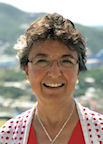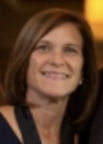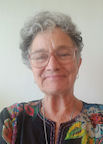Would you and your child like help to enjoy a deeper relationship with God?
Our parish supports and offers the Catechesis of the Good Shepherd (CGS) which fosters the spiritual lives of 500 students and parish children weekly. CGS is one of the most important experiences in forming disciples. It is a formation in contemplation and deep relationship with Jesus. The spirituality of the children and the adults that is nourished in the CGS Atrium environment has the potential to permeate the entire community, and to assist the family in living their faith more authentically.
The Catechesis of the Good Shepherd is an approach to the religious formation of children, rooted in Sacred Scripture, Liturgy, and respect for the child’s rich relationship with God. CGS has been called the meeting of two mysteries: the mystery of God and the mystery of the child. Its focus is on the personal relationship of Jesus, who is the fullest manifestation of the mystery of God, and the child. Jesus, the Good Shepherd, knows and calls His sheep by name to a life-long journey of growth and transformation. While CGS has its roots in the work and educational principles of Maria Montessori, its development, as we know it today, began in Rome in 1954 with Sofia Cavalletti and Gianna Gobbi.
The Nazareth House
The Nazareth House is the home of the Catechesis of the Good Shepherd (CGS) here at our parish.
The Nazareth House is where the Catechesis of the Good Shepherd method of faith formation is offered for the Catholic School students, the Parish School of Religion children, the parish home school families, and the young parishioners with special needs.
The Nazareth House is also a House of Formation for those being trained to be CGS Catechists in all levels. Those who work with the children will participate in nearly 100 hours of formation to become CGS Catechists and will prepare a special environment for the children, which is called the Atrium. The Nazareth House has a chapel, a dedicated atrium for each of the three Levels of CGS and a space for materials making.
To learn more about the Catechesis of the Good Shepherd at our parish, please contact the Nazareth House Administrator or to find the complete information on The United States Association of The Catechesis of the Good Shepherd, visit www.CGSUSA.org.
Nazareth House Administrator
Fey Barles
CGS Levels I, II and III Catechist
316-871-4008 (mobile)
316-722-5171 (office)
News & Notes
To schedule days and times in Nazareth House, please email to receive the SFA CGS Nazareth House Reservation and Agreement Form. Please indicate in your email which of the following best describes you or your group:
- Catholic school students
- Parish School of Religion youth
- SFA parish homeschool family/ies
- SFA young parishioners with special needs
- Other (please specify in your email)
Please visit The CGS Nazareth House Notebook for the most current information, news & notes
Course Schedule for Levels I, II, and III Formation
Our parish is hosting several Catechesis of the Good Shepherd Catechist Formation Courses led by Formation Leaders Marty O’Bryan and Sandra McCutchon.
Level I Formation is scheduled from July 2022 – March 2023 with eight weekends starting July 29-31, 2022.
Level II Formation is scheduled from July 2021 – July 2022 with Part Two on July 21-28, 2022 that includes a Sample Day of Retreat for Sacramental Preparation. Another Level II Formation is scheduled from July 2024 – July 2025.
Level III Formation is scheduled from March 2023 - May 2024 with eight weekends starting March 10-12, 2023.
To sign up, please complete the online form here, e-mail

Marty O’Bryan began her formation in the Catechesis of the Good Shepherd in 1983 with Sofia Cavalletti in Washington D.C. Her other formation leaders were Maria Christlieb from Mexico City & Rebekah Rojcewicz from the U.S. She has been conducting adult formations at Levels I, II and III throughout the United States since 1991.
A retired speech and language pathologist, Marty holds a Master of Arts degree in Pastoral Studies with an emphasis on the Catechesis of the Good Shepherd from Aquinas Institute of Theology. Currently, she works with children in Toddler and Level III atria in the Roman Catholic Diocese of Phoenix.

Sandra McCutchon has worked in Catechesis of the Good Shepherd since 2000. She opened three atria in her home parish and helped open an atrium that serves all three levels at a local Catholic school. Sandra has been formed in all three levels and is currently enrolled in the Master of Arts in Pastoral Studies - Catechesis of the Good Shepherd program at Aquinas Institute of Theology. She has 21 years of experience at all three levels and several years of experience leading formation courses for adults.
Sandra is a retired physician, catechist, wife, and mother of four, the youngest of which she has homeschooled from kindergarten through high school.

Mary Ellen Galvan is an experienced teacher with extensive background in working with special needs children, Montessori and early childhood programs. She has been a catechist with CGS for twelve years, serving as a Level I, Level II and Level III catechist and pioneering atrium work with Middle School students as well. She is currently the coordinator for the Atrium at Incarnate Word Academy in Corpus Christi, Texas. Mary Ellen completed a Masters of Pastoral Studies in CGS at Aquinas Institute of Theology in 2019. She was also recognized as Level I CGS Formation Leader in 2019. Other aspects of spirituality that Mary Ellen brings to this work are a deep background in Ignatian spiritual direction and work as an iconographer.
Mary Ellen lives in Corpus Christi, Texas with her husband Steve. They have been married for forty-nine years and serve together as Level II catechists at the Corpus Christi Cathedral parish.
The Catechesis of the Good Shepherd is a Montessori-based religious formation program for children, beginning at the age of three. It seeks to create and facilitate a sacred, “hands-on” space for children called an atrium, in which both the children and the catechists can hear, ponder, and celebrate the most essential mysteries of the Christian faith as revealed in the scriptures and the liturgy. Originally developed in Rome by Dr. Sofia Cavalletti and Gianna Gobbi over 50 years ago, the Catechesis continues to spread world wide and is used with adaptation in various Christian traditions.
Atrium Open House on First Saturdays
Join us on every First Saturday of the Month after the 8:00 AM Holy Mass for an hour of open house / tour of the Catechesis of the Good Shepherd Atrium. Our catechist will be happy to share with you the materials that have allowed our young people to fall in love with Jesus and his Church.
Why is it called “atrium” anyway? The word “atrium” actually means “portico, or porch entrance to a large house.” The Atrium was a term given to this space by Maria Montessori. It was chosen because in the ancient church, the atrium was a gathering space between the Church Proper and the street. It was the place where the catechumens, those preparing for initiation to the Church, would receive instruction. The Atrium has a similar purpose for our children, as it is a place to help them enter into full, conscious, and active participation in the liturgical and communal life of the Church.
What is a “prepared environment”? The prepared environment is a Montessori concept that the environment can be designed to facilitate independent learning by the child. In a prepared environment, children work with materials of their own choice and at their own pace. They experience a combination of freedom and self-discipline in a place especially prepared to meet their developmental and spiritual needs.
“The atrium may be compared to a retreat house; as such it should be a place that facilitates recollection and silence, even in its external aspects of wall decorations and other furnishings. It is desirable that the atrium be “Mass-centered,” that is, a place where special prominence is awarded to the material relative to the Mass; a place where the baptismal font stands out in the area assigned to Baptism. The Gospel should have a position of honor and be located alongside the parable materials and materials relating to the historical life of Christ.” – Religious Potential of the Child by Sofia Cavalletti, p 56
Source: www.CGSUSA.org
A Reflection on CGS Sacramental Preparation and the Parish
The Pedagogy of God
The parish liturgy is the primary pedagogy of the people of God. The parish liturgy itself is a catechesis in which a child receives from the hands of his own pastor/vicar the Eucharist that initiates the child into his/her community of faith, the parish. For this reason, situating first communion in a parish liturgy is fitting to its reception.
Pastor as Shepherd
Delegation of first sacraments (of future children preferring the CGS retreat), if done regularly, could give the appearance that a pastor is ancillary to a child’s sacramental formation. In fact, the pastor is a proper formator of faith in a living relationship, not a relationship of utility. It is proper that a catechesis that is titled after a good Shepherd should culminate first sacraments being celebrated by child’s shepherd, the pastor (or vicars).
The First Atria
The physical Church, in which the parish’s Sunday Mass is weekly celebrated, is the first atria. All other atrium should ultimately lead back to the Child’s parish church, which would be highlighted by first communion at a parish liturgy.
An Introduction into the Parish Family
The sacraments of initiation are an introduction into the people of God, the primary expression of which is the local Church (diocese) as participated through the parish Church under a proper pastor. As such, they form an initial bond of communion to the parish community which represents the local church under the Bishop.
Primacy of Parish Family
Those who participate in CGS form a genuine community that has a moral unity; yet it is not a parish family. One’s parish family forms the locus of pastoral care for one’s whole life. The parish is the permanent community through which all initiated Catholics receive pastoral care, evangelization, participate in the liturgy, call out in time of sickness, get married (often at the same altar they receive first communion), and eventually be buried. The sacraments of initiation introduce the faithful into the parish family, and are most fittingly celebrated in a parish liturgy.
The two most important points are: (1) the introduction into a parish family and (2) the role of pastor as shepherd in formation of a young person at the time of first sacraments.
Source: Fr. Jarrod Lies
Why is Our House Called Nazareth?
From an address by Pope Paul VI (Nazareth, January 5, 1964)
Nazareth, a model
Nazareth is a kind of school where we may begin to discover what Christ’s life was like and even to understand his Gospel. Here we can observe and ponder the simple appeal of the way God’s Son came to be known, profound yet full of hidden meaning. And gradually we may even learn to imitate him.
Here we can learn to realize who Christ really is. And here we can sense and take account of the conditions and circumstances that surrounded and affected his life on earth: the places, the tenor of the times, the culture, the language, religious customs, in brief, everything which Jesus used to make himself known to the world. Here everything speaks to us, everything has meaning. Here we can learn the importance of spiritual discipline for all who wish to follow Christ and to live by the teachings of his Gospel.
How I would like to return to my childhood and attend the simple yet profound school that is Nazareth! How wonderful to be close to Mary, learning again the lesson of the true meaning of life, learning again God’s truths. But here we are only on pilgrimage. Time presses and I must set aside my desire to stay and carry on my education in the Gospel, for that education is never finished. But I cannot leave without recalling, briefly and in passing; some thoughts I take with me from Nazareth.
First, we learn from its silence. If only we could once again appreciate its great value. We need this wonderful state of mind, beset as we are by the cacophony of strident protests and conflicting claims so characteristic of these turbulent times. The silence of Nazareth should teach us how to meditate in peace and quiet, to reflect on the deeply spiritual, and to be open to the voice of God’s inner wisdom and the counsel of his true teachers. Nazareth can teach us the value of study and preparation, of meditation, of a well-ordered personal spiritual life, and of silent prayer that is known only to God.
Second, we learn about family life. May Nazareth serve as a model of what the family should be. May it show us the family’s holy and enduring character and exemplify its basic function in society: a community of love and sharing, beautiful for the problems it poses and the rewards it brings, in sum, the perfect setting for rearing children – and for this there is no substitute.
Finally, in Nazareth, the home of a craftsman’s son, we learn about work and the discipline it entails. I would especially like to recognise its value – demanding yet redeeming – and to give it proper respect. I would remind everyone that work has its own dignity. On the other hand, it is not an end in itself. Its value and free character, however, derive not only from its place in the economic system, as they say, but rather from the purpose it serves.
In closing, may I express my deep regard for people everywhere who work for a living. To them I would point out their great model, Christ their brother, our Lord and God, who is their prophet in every cause that promotes their well being.
Source: http://www.liturgies.net/saints/holyfamily/officeofreadings.htm


